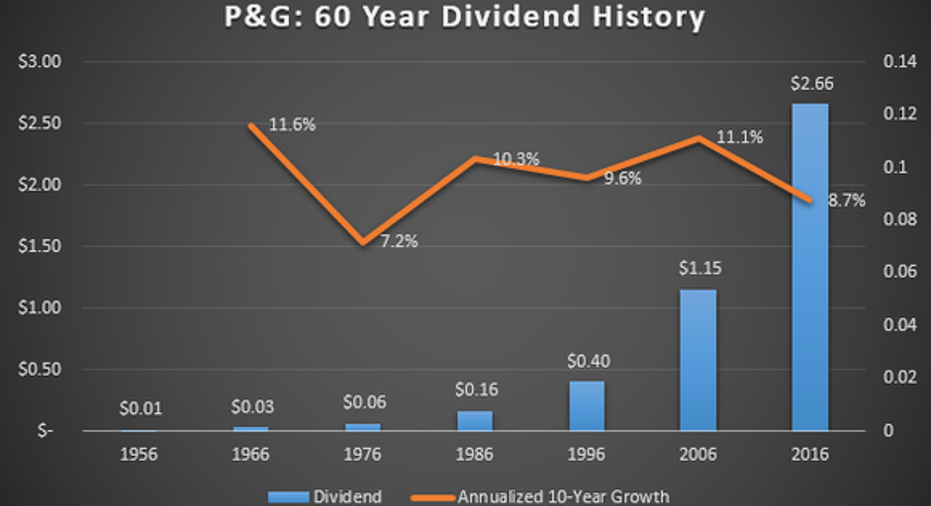5 Things Investors Need to Know About Procter and Gambles Dividend

Getty Images
Consumer goods companies tend to be ignored by the financial media. But while journalists and pundits are busy discussing the next hot technology, gadget or luxury car line, consumer goods companies are quietly churning out the vast majority of products we buy at grocery stores and big-box retailers.
Long-term buy-and-hold investors can benefit from having so-called "boring" consumer goods companies in their portfolio. For example, the S&P 500 has provided investors with an annualized total return of 6.24% over the last 15 years, while household and personal consumer products companies have returned 8.99% annually, according to Morningstar's data. Or, presented another way: $10,000 invested in the S&P 500 15 years ago would be worth $24,793, while the same amount in invested in household and personal products makers would be worth $36,375.
Going forward, a large part of investor returns from this industry will come from dividends, given that large industry players like The Clorox Company and Unilever pay yields above the S&P average. However, Procter and Gamble (NYSE: PG), the biggest consumer goods company, has a higher yield than either of them. Here's what investors need to know about Procter and Gamble's dividend.
126 years of dividend payouts
Procter and Gamble is not shy about returning cash to shareholders. The company has been paying a dividend for 126 consecutive years, since directly after the company's original incorporation in 1890. The fact that it has paid dividends so long shows its commitment to doing so, and the current level is $2.68 a year -- good for a yield of 3.1%.
P&G is a dividend aristocrat three times over
The term "dividend aristocrat" is used to acknowledge S&P 500 companies that have increased their payouts at least once a year for 20 years or more. Not only is Procter and Gamble on the list, it could be on the list three times over: The company has boosted its dividend annually for the last 60 years.
Dividend growth has slowed, but is still exceptional
The pace of growth is interesting as well. Overall, P&G has increased its annualized dividend from $0.01 to $2.66 as of the end of fiscal 2016. Over the span of 60 years, this is equal to dividend increases of 9.8% per year. This isn't front loaded growth either; with the exception of the 10-year period that ended in 1976, its annualized dividend increases have been no lower than 1 percentage point from its long-term average.
Data Source: P&G's annual report.
It should be noted the annualized rate of growth has slowed to 5% over the last five years. But the company continues to return cash to shareholders; it spent $14.6 billion on share repurchases in the last three years alone.
The dividend is supported by operations
The most important issue regarding a stock for income investors is the sustainability of the dividend: Can the company continue to pay the dividend at its current levels? On that front, P&G does not have any issues. Over the past three years, the company has a free-cash-flow (defined as cash from operations minus capital expenditures) payout ratio of less than 70%.
Data Source: P&G's 10K.
The company's cash position is better than advertised
The only warning sign in the company's financials as they relate to the dividend was the company's rather low cash balance. P&G reported $7.1 billion in cash and cash equivalents in its most recently filed annual financial report. Overall, this appears to be a rather small bankroll for a company that paid more than $7.4 billion in total dividends last fiscal year.
However, the company has another $6.2 billion in available-for-sale investment securities, and the vast majority of assets in this line item are highly liquid U.S. government and mostly liquid corporate bond securities. In the event P&G's operations are unable to support the dividend, which appears to be an improbable scenario considering the payout ratio, the company has approximately two years worth of dividends available before it would have to turn to external financing.
While it's exciting to invest in the next big thing, don't overlook investing in the products you purchase and consume on a daily basis.
A secret billion-dollar stock opportunity The world's biggest tech company forgot to show you something, but a few Wall Street analysts and the Fool didn't miss a beat: There's a small company that's powering their brand-new gadgets and the coming revolution in technology. And we think its stock price has nearly unlimited room to run for early in-the-know investors! To be one of them, just click here.
Jamal Carnette has no position in any stocks mentioned. The Motley Fool recommends Procter and Gamble. Try any of our Foolish newsletter services free for 30 days. We Fools may not all hold the same opinions, but we all believe that considering a diverse range of insights makes us better investors. The Motley Fool has a disclosure policy.